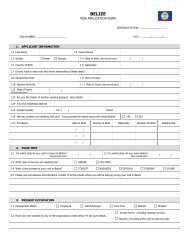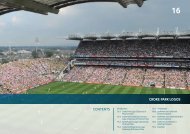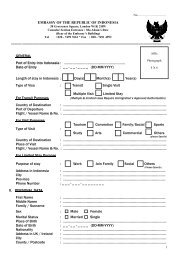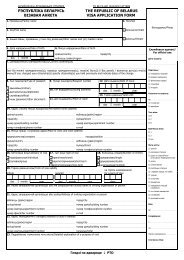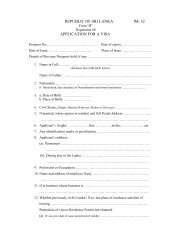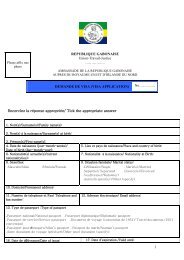Tourism ABC - Dublin Chamber of Commerce
Tourism ABC - Dublin Chamber of Commerce
Tourism ABC - Dublin Chamber of Commerce
You also want an ePaper? Increase the reach of your titles
YUMPU automatically turns print PDFs into web optimized ePapers that Google loves.
Table <strong>of</strong> ContentsEXECUTIVE SUMMARY .................................................................................. III1. INTRODUCTION .......................................................................................12. BUSINESS TOURISM .................................................................................22.1 THE IMPORTANCE OF BUSINESS TOURISM TO THE DUBLIN ECONOMY ..................... 22.2 AIR ACCESS…………………………………………………………………………………………………….42.3 BUSINESS PRODUCT INFRASTRUCTURE DEFICIT…………………………………………………..52.4 VAT REFUNDS FOR BUSINESS TRAVELLERS…………………………………………………………62.5 RECOMMENDATIONS…………………………………………………………………………………………73. CULTURAL TOURISM…………………………………………………………………………83.1 SIGHTSEERS AND CULTURALISTS - A GROWING SEGMENT ................................. 83.2 OPTIMIZING THE EXISTING PRODUCT…………………………………………………………………..93.3 EXPANDING THE PRODUCT RANGE………………………………………………………………..……103.4 INNOVATIVE PROGRAMME PLANNING……………………………………………………….…………113.5 RECOMMENDATIONS …………………………………………………………………………….………..124. TOURISM ENVIRONMENT………………………………………………………………….144.1 THE CITY AS A BACKDROP TO TOURISM..................................................... 144.2 VISUAL IMPACT……………………………………………………………………………………………..144.3 TRANSPORT AND ACCESS…………………………………………………………………………………164.4 RECOMMENDATIONS…………………………………………………………………………………….…185. OVERVIEW………………………………………………………………………………….20APPENDIX……………………………………………………………………………………….21ii
Executive SummaryThe tourism sector is a vital component <strong>of</strong> the <strong>Dublin</strong> economy, and contributes ina unique and dynamic way to the city’s cultural mix and vibrancy. As Irelandbecomes increasingly expensive, it is imperative that steps are taken in the areas<strong>of</strong> ‘business tourism’ and ‘cultural tourism’ to ensure that the tourism “product” isregenerated to attract higher value-added customers to the city. <strong>Dublin</strong> shouldaspire to become a leading destination for business and cultural tourists by theend <strong>of</strong> the decade.The business tourism market is a key market segment for the <strong>Dublin</strong> region.Government must act in a more comprehensive and concerted way to help growthis market. Ireland’s performance in attracting high margin business tourists hasbeen stagnant at best since the beginning <strong>of</strong> the decade. Modest growth targetshave been set for 2007 and even these targets will require concerted action toachieve them. <strong>Dublin</strong> is ranked in 20 th place as the best location for businesstourists, behind such cities as Vienna, Barcelona and Berlin.The urgent development <strong>of</strong> the National Conference Centre and certainty over itsopening date is an initial step in a series <strong>of</strong> actions required to sustain thepr<strong>of</strong>itable business tourism sector. Government should proactively enhance anddevelop existing public venues to cater for large audience numbers (in excess <strong>of</strong>300 persons). In the longer term, conversion <strong>of</strong> government buildings vacatedthrough decentralisation would <strong>of</strong>fer prestige venues for state and businessfunctions. In addition, local interests must not hinder the prompt development <strong>of</strong>Pier D and the second terminal and runway at <strong>Dublin</strong> Airport.There is a need for a single coherent voice in <strong>Dublin</strong> to represent, in an articulateway, the wide range <strong>of</strong> bodies that operate in the cultural tourism sector. ACultural Ambassador would ensure that <strong>Dublin</strong>’s heritage and attractions arepresented in a structured fashion. This individual should operate within <strong>Dublin</strong><strong>Tourism</strong> and provide a comprehensive listing <strong>of</strong> events and proactively market aseries <strong>of</strong> thematic programmes. The Department <strong>of</strong> Arts, Sport and <strong>Tourism</strong>should put cultural institutions on a multi-annual funding envelope to maximisemarketing opportunities.The new regional structure for tourism being developed by Fáilte Ireland suggeststhat <strong>Dublin</strong> <strong>Tourism</strong> will have the lead role for promoting all tourist activities iniii
the city. We believe that this is appropriate and that <strong>Dublin</strong> <strong>Tourism</strong> should havea clear accountable mandate to be responsible for developing and increasing thetourism market in <strong>Dublin</strong>.The recommendations <strong>of</strong> the <strong>Dublin</strong> <strong>Chamber</strong> are based on the <strong>Chamber</strong>’s visiondocument, Imagine <strong>Dublin</strong> 2020. Building upon <strong>Dublin</strong>’s unique history andculture, our vision is to ensure that <strong>Dublin</strong> shall be:• An accessible city;• A safe city;• A clean and visually attractive city;• A welcoming location for tourists, where standards <strong>of</strong> service arepersonable and pr<strong>of</strong>essional; and• An interesting and fun place to be.iv
ActionsResponsibilityActions to improve customerservices at <strong>Dublin</strong> Airport must beimplemented on a continuous basis.Pier D must be operational by 2007and Terminal Two completed by2009.A high calibre, comprehensivemarketing plan must be put in placeto sell <strong>Dublin</strong> as destination forconferences and meetings,especially in relation to the NationalConference Centre.Existing, and new, non-hotel venuesmust be identified and transformedto facilitate after-hours businessevents for groups more than 250persons.VAT on legitimate corporateexpenditure by overseas businesstourists (accommodation andrestaurant expenses) should berefundable.The position <strong>of</strong> ‘CulturalAmbassador’ should be created.They would champion an identifiablecultural brand for <strong>Dublin</strong> city.A holistic marketing policy for theArts must be put in place, with acomprehensive listing <strong>of</strong> culturalevents in the city.Opening hours <strong>of</strong> cultural attractionsmust be extendedLicensing Laws should be reviewedin light <strong>of</strong> a lack <strong>of</strong> alternativelocations for language students etc.to attend.Multi-annual funding for the ArtsImprove the visual impact <strong>of</strong> thecity: Remove litter, improve civicspaces & make good following repairwork<strong>Dublin</strong> Airport Authority<strong>Dublin</strong> Airport Authority, Department <strong>of</strong>Transport<strong>Dublin</strong> Convention Bureau, Department <strong>of</strong>Arts, Sport and <strong>Tourism</strong>OPW, Department <strong>of</strong> Arts, Sport and<strong>Tourism</strong>Department <strong>of</strong> Finance, RevenueCommissioners<strong>Dublin</strong> <strong>Tourism</strong><strong>Dublin</strong> <strong>Tourism</strong> in association with <strong>Dublin</strong>City Council and other stakeholders.Department <strong>of</strong> Arts, Sport and <strong>Tourism</strong>Department <strong>of</strong> Arts, Sport and <strong>Tourism</strong>,Department <strong>of</strong> Justice, Equality and LawReformDepartment <strong>of</strong> Arts, Sport and <strong>Tourism</strong>,Department <strong>of</strong> Finance<strong>Dublin</strong> City CouncilIntegrate Public Transport Department <strong>of</strong> Transport through the<strong>Dublin</strong> Transport AuthorityImprove signage around the city <strong>Dublin</strong> City CouncilCreate safe parking and drop <strong>of</strong>f <strong>Dublin</strong> City Councillocations around the cityImprove the standard <strong>of</strong> taxi service The Commission for Taxi Regulationin the cityv
1. Introduction<strong>Tourism</strong> is one <strong>of</strong> Ireland’s principal generators <strong>of</strong> economic activity. In 2005overseas visitor numbers peaked at an all-time high <strong>of</strong> almost 7 million, resultingin earnings <strong>of</strong> €4.3 billion and employment <strong>of</strong> approximately 246,000 people inthe tourism and hospitality industry 1 . Due to trends such as shorter city breaks,cheaper airline travel and shorter booking times, coupled with the airport andport remaining the main gateways to the island <strong>of</strong> Ireland, <strong>Dublin</strong> has continuedto increase its visitor numbers with average annual growth <strong>of</strong> 8% since 1999.Last year alone, <strong>Dublin</strong> city received a total <strong>of</strong> 3.9 million overseas visitors.These tourists injected almost €1.3 billion into the economy, and spentapproximately 18 million nights in accommodation throughout the city.The tourism sector is a vital component <strong>of</strong> the <strong>Dublin</strong> economy and contributes ina unique and dynamic way to the city’s cultural mix and vibrancy. However, as<strong>Dublin</strong> becomes a more expensive location, there is a need to regenerate <strong>Dublin</strong>’stourism “product” to assure value for money, and to continue to attract highervalue-added customers to the city. <strong>Dublin</strong> <strong>Chamber</strong> <strong>of</strong> <strong>Commerce</strong> has a vision tocreate by 2020, a city that is a world leader in terms <strong>of</strong> quality <strong>of</strong> life for all it’scitizens, whether living, working or visiting. The attractiveness <strong>of</strong> <strong>Dublin</strong> as adestination shall be founded upon the city’s unique history and culture, and byensuring that <strong>Dublin</strong> is:• An accessible city;• A safe city;• A clean and visually attractive city;• A welcoming location, where standards <strong>of</strong> service are personable andpr<strong>of</strong>essional; and• An interesting and fun place to be.In order to realise this vision, the <strong>Dublin</strong> <strong>Chamber</strong> <strong>of</strong> <strong>Commerce</strong> believes action isrequired in three areas <strong>of</strong> tourism:• Business <strong>Tourism</strong>;• Cultural <strong>Tourism</strong>; and• The overall <strong>Tourism</strong> Environment.1 This includes hotels, guesthouses, self-catering facilities, restaurants, licensed premises, tourismservices and attractions.1
2. Business <strong>Tourism</strong>2.1 The Importance <strong>of</strong> Business <strong>Tourism</strong> to the <strong>Dublin</strong> EconomyFáilte Ireland has set a target for the value <strong>of</strong> overseas business tourism revenue<strong>of</strong> €470m by 2007. Revenue has stagnated in recent years, falling from a high <strong>of</strong>€460m in 2001 to €424m in 2004. Although expenditure rose to €457m in 2005,concerted action shall be required to realize 2007’s target.There is a need to actively deal with the issues currently discouraging meetingplanners from selecting <strong>Dublin</strong> as a destination, to prevent a further decline in theshare <strong>of</strong> business tourism that <strong>Dublin</strong> attracts. Actions must be taken to dealwith the city’s infrastructure deficits, including the current lack <strong>of</strong> acomprehensive timetable for the completion <strong>of</strong> the National Conference centre,the lack <strong>of</strong> availability <strong>of</strong> suitable accommodation facilities and entertainmentvenues for large groups, and also the lack <strong>of</strong> transport facilities city wide andsuitable resources at the airport. <strong>Dublin</strong> has been ‘punching above its weight’ inthe business tourism market, despite the lack <strong>of</strong> supporting facilities and policies.In 2005, the International Congress and Convention Association ranked <strong>Dublin</strong>20 th in terms <strong>of</strong> attractiveness for hosting meetings. Concerted action is requiredto raise the city’s ranking to the top five by 2010.Fig 1: Overseas visits to Ireland by Business Tourists, 2001-05900800839779734796831700Revenue (€m) & Volume ('000)60050040030020045143639441644810002001 2002 2003 2004 2005YearNo. <strong>of</strong> overnight business touristsRevenue (€m) from overnight touristsSource: <strong>Dublin</strong> <strong>Chamber</strong> <strong>of</strong> <strong>Commerce</strong> deviation from CSO data.2
An important segment <strong>of</strong> Ireland’s business tourism market is the promotablebusiness segment. In 2005 this segment accounted for just less than one-third <strong>of</strong>all business visitors, but nearly half <strong>of</strong> all expenditure. <strong>Dublin</strong> continues to attractthe vast majority <strong>of</strong> Ireland’s business tourism market, due to its facilities,transport infrastructure and the number <strong>of</strong> Government and private sector HQfacilities located in the capital. Fáilte Ireland estimates that approximately 75%<strong>of</strong> the high value-added promotable business segment is attracted to <strong>Dublin</strong>. In2005, this contributed approximately €165m to the <strong>Dublin</strong> economy.Table 1: Promotable Business SegmentNo. <strong>of</strong> overnightvisitorsTotal Business <strong>Tourism</strong> 2005 857,000Revenue (€m)456.6Promotable Business:International Conference 89,000 85.4Corporate Meeting 147,000 111.8Trade Fair / Exhibition 27,000 22.7Total Promotable Business 263,000 219.9Promotable Section as % <strong>of</strong> TotalBusiness <strong>Tourism</strong> 31% 48%Source: Fáilte IrelandNote: Total figure differs from fig. 1 due to differencing in measurement methodology. Failte Irelandfigure is taken from CSO’s data (831,000 visitors), plus the business tourists entering via NorthernIreland (26,000)<strong>Dublin</strong> is not a world-class destination for business tourism. In order for <strong>Dublin</strong> toaggressively pursue the promotable business segment, <strong>Dublin</strong> <strong>Chamber</strong> hasidentified the following as key issues that must be addressed:2.2 Airport facilities in <strong>Dublin</strong>;2.3 The business product infrastructure deficit; and2.4 VAT refunds on accommodation and restaurant costs for businesstravellers.3
2.2 Air AccessAir access is critical for Ireland and is the primary question <strong>of</strong> any internationalclient when considering a destination - be it for leisure or business. While theadvent <strong>of</strong> low cost carriers has improved access to <strong>Dublin</strong>, the low cost carrierservice model employed by many airlines does not fully meet the requirements <strong>of</strong>the business tourism sector. This sector has a different subset <strong>of</strong> needs thanthose <strong>of</strong> leisure travellers 2 . Thus, we believe there is a commercial case to bemade in relation to accommodating the needs <strong>of</strong> the business tourism market -particularly on routes into <strong>Dublin</strong> that capture the majority <strong>of</strong> direct and transferpassengers, such as London, Paris, Frankfurt and Amsterdam. The availability <strong>of</strong>a dedicated business executive to liase with operators for business grouppurposes, and to develop a booking system to facilitate group reservations in themajor airlines would be a useful starting point.We believe it is essential that <strong>Dublin</strong> have a world-class international airport withsufficient capacity to accommodate rising demand. Between 1992 and 2004there was a compound annual growth rate <strong>of</strong> 9.4% in passenger numbersthrough <strong>Dublin</strong> airport. By the year 2020 passenger numbers are expected toreach 33 million, which is effectively a doubling <strong>of</strong> the 17 million passengers thatwere received in 2004 3 .Over the next ten years, the <strong>Dublin</strong> Airport Authority (DAA) plans to increaseairport terminal and airside capacity to facilitate the 30 million passengersexpected per annum. The current facilities are at breaking point and the DAA isdoing its utmost to accommodate the volume <strong>of</strong> passengers.With current growth <strong>of</strong> over a million extra passengers per annum, thedevelopments proposed by the DAA, including the building <strong>of</strong> a second terminaland a second main runway, are vital to future growth. It is imperative that nodelays occur and that the proposed dates <strong>of</strong> delivery are adhered to, with Pier Doperational by 2007 and Terminal Two completed by 2009. In addition, thetimely provision <strong>of</strong> enhanced road access and a conveniently located Metro Northrail link to the city centre are critical.2 These include: the need for a dedicated contact person to address specific requests, enquiries orreservations; the need for amendments in booking facilities as the policy <strong>of</strong> requiring specific namesand immediate payment is not compatible with the preliminary stage <strong>of</strong> meeting planning.3 <strong>Dublin</strong> Airport Stakeholders Forum, 16 th November 2005.4
2.3 Business Product Infrastructure DeficitA destination that can <strong>of</strong>fer a comprehensive package <strong>of</strong> hotel rooms, meetingvenues and good transport facilities will be better positioned to attract businessvis-à-vis competitor destinations. <strong>Dublin</strong> must deal immediately with its currentinfrastructure deficit and expand its <strong>of</strong>ferings to ensure that potential conferenceplanners and organisers have a comprehensive business tourism product to <strong>of</strong>fervisitors. <strong>Dublin</strong> <strong>Chamber</strong> has identified two important gaps in <strong>Dublin</strong>’sinfrastructure, which if dealt with would improve the city’s pr<strong>of</strong>ile andattractiveness as a business tourism destination.Firstly, there is a lack <strong>of</strong> non-hotel venues suitable to host a dinner reception forcapacities in excess <strong>of</strong> 250 persons. A recent health & safety check on the RoyalHospital Kilmainham resulted in the maximum numbers being reduced to 270.This was a severe blow to the industry. The <strong>Dublin</strong> <strong>Chamber</strong> calls for creativediscussion and co-operation between local and national Government, stateagencies, third level institutions and the business community to identify possiblevenues for business tourism events by 2007. Existing venues and new sitesneed to be identified. Possible venues, which could immediately becomeavailable through such co-operation, include:• The use <strong>of</strong> public parks for marquees; and• A permanent marquee in the IFSC, like the Spiegeltent.In the longer term, the conversion <strong>of</strong> government buildings vacated throughdecentralisation would <strong>of</strong>fer prestige venues for state and business functions.The Custom House is one such example. This building completed in 1791 isconsidered to be, architecturally, one <strong>of</strong> the most important buildings in <strong>Dublin</strong>.During the civil war the interior <strong>of</strong> the building was destroyed. Since then hugestate investment has been put into its refurbishment. This Georgian building is amagnificent structure and would be an ideal venue for large-scale functions.Other sites that would provide suitable, high-status venues if developed include:• The OPW sites at Military Road, Infirmary Road and Parkgate St.;• Collins Barracks;• The proposed Theatre site at Grand Canal Basin;• A redeveloped Lansdowne Road stadium; and• The extended National Concert Hall, including the UCD space to bevacated in Earlsfort Terrace.5
The second gap in <strong>Dublin</strong>’s infrastructure is the lack <strong>of</strong> clarity surrounding theproposed National Conference Centre. Presently, conference organisers cannotbe certain as to the internal infrastructure <strong>of</strong> the centre, in terms <strong>of</strong> exhibitionspace and a seating plan, nor is there a specific guaranteed completion date. Thecurrent proposed opening date is Autumn 2009 but without a guarantee, therewill be little in the way <strong>of</strong> international conferences held that year.In order to ensure that tour operators can market <strong>Dublin</strong> as a destination, totalconfidence must be engendered within the international business tourismcommunity that the National Conference Centre shall be delivered on time. Thelack <strong>of</strong> visibility and clarity that surrounds this piece <strong>of</strong> infrastructure is hinderingany substantial growth in <strong>Dublin</strong>’s proportion <strong>of</strong> the business tourism market.Since the selection <strong>of</strong> a destination is <strong>of</strong>ten made to 3-4 years in advance, specificinformation regarding the opening date and internal layout <strong>of</strong> the centre must beissued immediately to allowing for a high calibre, comprehensive marketing planto be put in place. In addition, sufficient resources must be allocated to the<strong>Dublin</strong> Convention Bureau to ensure this marketing plan becomes a reality.2.4 VAT Refunds for Business TravelersIreland has the sixth highest rate <strong>of</strong> VAT on accommodation in the EU25, andhigh levels <strong>of</strong> excise duty on wine, beer and cider. This high level <strong>of</strong> indirecttaxation is pricing <strong>Dublin</strong>, and Ireland, out <strong>of</strong> some tourism markets and having adirect negative impact on competitiveness.Many competitor countries within the EU are allowing a deduction in VAT onlegitimate accommodation and restaurant expenses as a business expense. Thus,whilst Denmark, Germany and Hungary have higher nominal VAT rates thanIreland’s 13.5%, they allow for a complete recovery <strong>of</strong> input VAT incurred bybusiness travellers and therefore <strong>of</strong>fer a lower effective rate <strong>of</strong> taxation.As <strong>Dublin</strong> is the primary venue in Ireland for business travellers, this disparitysignificantly inhibits <strong>Dublin</strong>’s ability to compete internationally for businessevents. We believe the lack <strong>of</strong> a similar policy in <strong>Dublin</strong> results in the loss <strong>of</strong>potential business. Thus, we believe that the VAT on legitimate corporate6
expenditure in hotels and restaurants for conferences, incentive travel andcorporate meetings should be refundable.2.5 RecommendationsAir Access• <strong>Dublin</strong> Airport Authority must implement actions to improve customerservices at <strong>Dublin</strong> Airport on a continuous basis.• Government must take whatever steps are necessary to ensure that theDAA has sufficient funding resources to provide for the projected increasesin passenger numbers and ensure that Pier D is operational by 2007 andTerminal Two completed by 2009.Business Product Infrastructure Deficit• Adequate funding should be allocated to <strong>Dublin</strong> Convention Bureau toenable it to effectively market <strong>Dublin</strong> as destination for conferences andmeetings, especially in relation to the National Conference Centre.• The OPW should proactively identify, and open, new venues that canfacilitate the needs <strong>of</strong> the business tourism sector, with particularreference to buildings that shall become available after decentralisation.• The Health and Safety Authority should work with industry and <strong>Dublin</strong>Local Authorities to develop an independent health & safety audit for allnon-hotel venues. If capacity <strong>of</strong> a venue is to be reduced over health andsafety concerns then the Health and Safety Authority should workproactively with the venue management and the OPW to address theconcerns raised with a view to retaining the existing capacity.• Fáilte Ireland should identify the current gaps in <strong>Dublin</strong>’s infrastructuredeficit and highlight these gaps as private and public sector opportunities.There is a need to identify opportunities in the tourism sector, much in thesame fashion as the IDA have done in other sectors.VAT Refunds for Business Travellers• Government should allow overseas business visitors to recoup VAT onlegitimate business expenditure on accommodation and restaurantexpenses.7
3. Cultural <strong>Tourism</strong>3.1 Sightseers and Culturalists - A Growing SegmentResearch carried out by <strong>Tourism</strong> Ireland indicates that the best prospect fortourism growth in <strong>Dublin</strong> is the ‘sightseers and culturalists’ sub-sector.Representing a core segment <strong>of</strong> over 2 million holidaymakers into Ireland in2004, with approximately 1 million staying overnight in <strong>Dublin</strong>, visitor needs forthis sub-sector include sightseeing, culture, festivals, historic Irish culture andshopping (antiques, Irish goods).The important economic impact <strong>of</strong> this segment has been highlighted in othercities in Europe. The tourist sector in Bilbao has benefited greatly from theopening <strong>of</strong> the Guggenheim Museum. Since its inauguration in 1997, theGuggenheim in Bilbao has received more than 8.13 million visitors, and in 2005 itgenerated economic activity in the Basque region worth €186.2 million. Overallthe Guggenheim’s direct and induced impact on the generation <strong>of</strong> wealth in thearea has been 18 times more than the initial public investment into its creation.The Tate Gallery <strong>of</strong> Modern Art, which opened in Southwark, London in 2000, isanother example <strong>of</strong> the importance <strong>of</strong> cultural attractions. In its first year, theTate Modern’s collected revenue had far exceeded expectations. It had generatedaround £100million, <strong>of</strong> which £50 to £70 million went to the local area, and hadbecome the third most visited tourist attraction in Britain. Furthermore, themuseum helped regenerate the South bank and Bankside area <strong>of</strong> London bydrawing attention, and people, to a previously undiscovered and undevelopedarea.The aim <strong>of</strong> <strong>Dublin</strong> <strong>Chamber</strong> <strong>of</strong> <strong>Commerce</strong> is to ensure that this segment <strong>of</strong>visitors is attracted to the city by ensuring that a full and varied programme canbe organized during ones stay, and in terms <strong>of</strong> infrastructure, that <strong>Dublin</strong> city hasgood signage, transport facilities and well-developed sporting facilities 4 etc. Wewish for the sightseers and culturalists to leave with positive memories <strong>of</strong> athriving cultural city with a unique atmosphere, thereby advertising the city as anexcellent destination to colleagues, friends and relatives. Indeed a positiveperception <strong>of</strong> the destination is critical as Fáilte Ireland estimate that a4 <strong>Dublin</strong> <strong>Chamber</strong> <strong>of</strong> <strong>Commerce</strong> supports the redevelopment <strong>of</strong> Lansdowne Road.8
dissatisfied customer tells two to three times as many people about their badexperience than a satisfied customer.Four key issues must be addressed to capitalise on this growing segment <strong>of</strong> themarket. These include:3.2 Optimising the existing product;3.3 Expanding the product range;3.4 Innovative programme planning; and3.5 High levels <strong>of</strong> accommodation standards.3.2 Optimizing the Existing Product3.2.i Marketing Policy for the ArtsDue to short lead-times and a lack <strong>of</strong> marketing expertise in the Arts field, thereis no cogent, holistic marketing policy for the arts in <strong>Dublin</strong>. In addition, it isdifficult to access information on <strong>Dublin</strong>’s cultural programme. This is evident at<strong>Dublin</strong> airport and other access points to the city, where potential exists fordedicated information to be supplied to visitors regarding facilities/ events/activities in <strong>Dublin</strong>.The <strong>Chamber</strong> believes that there is a need to fund a large advertising campaignthat focuses upon the many existing cultural attractions in the city. There is anuntapped opportunity in the city for cultural attractions to be given a theme and“packaged”. This campaign requires the appointment <strong>of</strong> a Cultural Ambassadorwho would champion an identifiable cultural brand. We believe that this culturechampion should be based in <strong>Dublin</strong> <strong>Tourism</strong>.3.2.ii Opening Hours <strong>of</strong> Cultural CentreMany <strong>of</strong> the cultural centres in <strong>Dublin</strong> are closed on Mondays and in the eveningsand are limited to a few short opening hours on a Sunday. Cost factors and staffrelations are cited as difficulties in changing these arrangements, as there is noincentive to remain open due to free admission. However, as <strong>Dublin</strong> is now thethird most popular destination for short city breaks in Europe, the limited opening<strong>of</strong> cultural centres is an outdated tradition that no longer caters to the need <strong>of</strong>modern tourism, especially as these city breaks <strong>of</strong>ten span over long week-ends.9
3.3 Expanding the Product range3.3.iLicensing LawsThe new licensing laws are a barrier to the promotion <strong>of</strong> <strong>Dublin</strong> as a familyfriendly destination 5 . Under these rules, venues holding pantomimes cannotallow children into the bar at the interval and families with teenagers must beturned away from Irish Music performances when alcohol is served. Many barsnow serve competitively priced food, yet tourist families cannot avail <strong>of</strong> theseprices as they are prevented from eating in such establishments after 9pm if any<strong>of</strong> the party are under the age <strong>of</strong> 18 years.This issue has particularly impacted on the language student sector. Languageschools account for 200,000 visitors to Ireland every year and contribute€300million to the economy. These language schools need to <strong>of</strong>fer safeentertainment to students on a tight budget. However as in many cases thesestudents are under age, they cannot be taken to free ‘Irish’ entertainment in<strong>Dublin</strong> locations, and the cost <strong>of</strong> theatre tickets are invariably prohibitive. Thusthere is a need to provide Irish music evening and/or Irish themed activities tothis sub-section <strong>of</strong> visitors in venues that are not subject to licensing laws.3.3.ii Multi-Annual fundingContrary to the norm across all Government Departments, funding for the artsthrough the Arts Council is no longer approved on a multi-annual basis. Thismeans that organisations such as theatre groups must wait until their annualgrant has been confirmed before planning their programme for the year. Thetourism industry and tour operators need to have programmes in place up to 18months in advance in order to sell trips. As this is not the case, <strong>Dublin</strong>’s theatresand music venues are missing out on the important tourist market and are forcedto rely solely on local custom.5 Persons under the age <strong>of</strong> 18 years are only permitted in licensed premises if accommpanied by aparent or guardian, and it is between the hous <strong>of</strong> 10:30am-9pm in wintertime and 10:30am-10pmduring the period 1 st May to 30 th September. Persons aged between 15-17 years may remain on thepremises after 9 p.m. if attending a private function at which a substantial meal is being served.10
3.3.iiProgramming ‘Gaps’There is a need for greater coherency and balance in the annual programming <strong>of</strong>cultural events in the city. Whilst much planning surrounds events like the StPatrick’s Festival, the Theatre Festival and the Fringe Festival, there remain gapsand inaction between these events. This causes an imbalance in programming in<strong>Dublin</strong>. Almost all theatre companies are programming for the festival timeframe, and become less active at other times. Most theatre companies in <strong>Dublin</strong>avoid the summer period, as their target is the domestic market. The scarcity <strong>of</strong>daytime programmes such as matinee performances makes for a gap in activityas well as a missed business opportunity.The lack <strong>of</strong> a major festival in <strong>Dublin</strong> during the summer months, when attentionis focused on Galway, Tralee and Kilkenny for other major festivals, is a loss tothe city. Extra funding would allow providers to plan in advance, develop moreprogrammes and perform across seasons.3.4 Innovative Programme PlanningConsumers are increasingly using the Internet to research their holidaydestination and pre-book events. There is an urgent need for an Internet basedone-stop-shop to allow people to plan their itinerary in advance, from journeytimes on all transport facilities to commencement times <strong>of</strong> entertainment shows,and reserve tickets for these before arriving in <strong>Dublin</strong>. A major grant programmeis being put in place in Northern Ireland at the moment to network all venues andtourist <strong>of</strong>fices. This enables visitors to buy a ticket in any tourist <strong>of</strong>fice for a playor concert. A similar initiative is required in <strong>Dublin</strong>.<strong>Dublin</strong> <strong>Tourism</strong> has invested heavily in the technical side <strong>of</strong> the development <strong>of</strong>the ‘<strong>Dublin</strong> Pass’ using a ‘smart card’ chip. This allows full tracking <strong>of</strong> each cardand all its uses. Partners in the pass have the ability to have hourly and dailyprintouts <strong>of</strong> when and where cards are used through ‘reader’ machines. To date,over 60,000 visits have been made to visitor attractions using the <strong>Dublin</strong> Pass.Taking part in this programme <strong>of</strong>fers marketers the opportunity to gather a range<strong>of</strong> demographic and visitor habit information on their customers, which may beuseful in future programming. In addition, the pass is an efficient way <strong>of</strong>informing tourists <strong>of</strong> all the options available in <strong>Dublin</strong>.11
3.5 RECOMMENDATIONSOptimising the Existing Product• The current key performance measure for <strong>Dublin</strong> <strong>Tourism</strong> is the number <strong>of</strong>bed-nights sold. The performance <strong>of</strong> <strong>Dublin</strong> <strong>Tourism</strong> should be measuredby Fáilte Ireland on broader indicators including factors such as thenumber <strong>of</strong> referrals to cultural events and itineraries prepared for culturalevents.• Fáilte Ireland should target marketing campaigns at either a country orthematic level to highlight specific cultural events and provideaccompanying itineraries.• Culture Ireland should identify strategic locations worldwide to promoteIrish culture.• <strong>Dublin</strong> <strong>Tourism</strong> should work with the Theatre Forum, in association with<strong>Dublin</strong> City Council, <strong>Dublin</strong> Airport Authority and <strong>Dublin</strong> Port, to promotethe theatre and other attractions in all public spaces in <strong>Dublin</strong>• The Film <strong>Dublin</strong> partnership, with the co-operation <strong>of</strong> <strong>Dublin</strong> <strong>Tourism</strong> andFáilte Ireland, should work to maximise the exposure <strong>of</strong> <strong>Dublin</strong> on globalfilm and television.• The Department <strong>of</strong> Arts, Sport and <strong>Tourism</strong> should examine opening hours<strong>of</strong> cultural centres in <strong>Dublin</strong>, with a view to changing the times to moreuser-friendly hours. During the high season, changes should includeMonday opening, late opening mid-week, and earlier opening at theweekends. It is possible the same number <strong>of</strong> opening hours could be usedin a better way.• <strong>Dublin</strong> <strong>Tourism</strong> should appoint a ‘Cultural Ambassador’ for the city, who’sremit would include the provision <strong>of</strong> a comprehensive listing <strong>of</strong> events anda proactive marketing <strong>of</strong> a series <strong>of</strong> thematic programmes in the city.Expanding the Product Range• Arts organisations should consider <strong>of</strong>fering programmes during thesummer months that have an Irish theme, are cost effective, and operatein a safe environment for students, in particular those under the age <strong>of</strong> 18years.• The Department <strong>of</strong> Arts, Sport and <strong>Tourism</strong>, together with <strong>Dublin</strong> CityCouncil, should provide incentive funding for events in <strong>Dublin</strong> that12
highlight the culture <strong>of</strong> <strong>Dublin</strong>, and have an intrinsic value to the city. Thefund would provide a safety net for institutions/theatre companies todevelop events that <strong>Dublin</strong> is capable <strong>of</strong> delivering.• The Department <strong>of</strong> Finance should provide multi-annual funding for thearts. This would allow incentive funding to be made available to assistorganisations to confirm their programmes further in advance, and allowevents to be slotted into tour operators’ programmes.Innovative Programme Planning• <strong>Dublin</strong> <strong>Tourism</strong> should:a) Develop an internet based one-stop-shop service for tourists;b) Co-operate with existing established information providers, such as theTemple Bar Information Centre, to ensure that arts and culturalinformation is as up to date as possible; andc) Pro-actively market cultural events to tourists that have used <strong>Dublin</strong>tourist web site’s to book accommodation.• <strong>Dublin</strong> <strong>Tourism</strong> and the Temple Bar Information Centre should workproactively with all arts organisations in <strong>Dublin</strong> to gather a comprehensivelisting <strong>of</strong> cultural events in <strong>Dublin</strong> and make this available on the <strong>Dublin</strong><strong>Tourism</strong> and the Temple Bar Information Centre web sites.• <strong>Dublin</strong> <strong>Tourism</strong> should examine visitor behaviour through an analysis <strong>of</strong>use <strong>of</strong> the <strong>Dublin</strong> Pass smart card and share these results with touristorganisations. This would help to tailor future <strong>of</strong>fers to visitors to <strong>Dublin</strong>.13
4. <strong>Tourism</strong> Environment4.1 The City as a Backdrop to <strong>Tourism</strong><strong>Dublin</strong> <strong>Chamber</strong> <strong>of</strong> <strong>Commerce</strong> believes that tourism not only acts as a vitalcontributor to employment and economic activity in the city, it also contributes ina unique and dynamic way to <strong>Dublin</strong>’s cultural mix and vibrancy. As such, it iscritical that a cohesive vision and strategic approach should underpin the tourismindustry in the city. We believe that an environmental consciousness should be acornerstone <strong>of</strong> that vision. The key priorities requiring immediate action are thevisual impact <strong>of</strong> <strong>Dublin</strong> and transport in the city.Co-operation will be required among many different players to address theseissues. However, it shall be the engagement and active participation <strong>of</strong> <strong>Dublin</strong>City Council in delivering solutions that will be <strong>of</strong> critical importance.4.2 Visual ImpactIn terms <strong>of</strong> visual impact, three areas need to be addressed urgently:4.2.i Litter;4.2.ii Optimising Civic Space; and4.2.iii Making good following repair work.4.2.iLitterRegarding the cleanliness <strong>of</strong> the city, <strong>Dublin</strong> compares unfavourably withEuropean cities <strong>of</strong> a similar size and also with large urban centres like London andChicago, which are a multiple <strong>of</strong> <strong>Dublin</strong>’s size. Litter, most particularly thepervasiveness <strong>of</strong> chewing gum and paper debris, is the most visible contributor tothis problem. At a more general level, over-flowing bins, littered streets andunsightly vandalism contributes to a sense <strong>of</strong> a city lacking in civic pride.Addressing individual propensity to litter is a long-term process that shall requireeducation and changes in behaviour. However, more immediate solutions arerequired in the interim period. In particular, retailers must be made accountablefor the litter environment outside their premises.14
The cost to <strong>Dublin</strong> City Council <strong>of</strong> cleaning chewing gum <strong>of</strong>f Grafton Street, HenryStreet and O’Connell Street alone was €130,000 in 2005 (€250,000 city wide).The recent contribution by Wrigley’s (who account for 90% <strong>of</strong> the Irish chewinggum market) <strong>of</strong> €2m towards education and research on the problem <strong>of</strong> gumlitter is to be welcomed, as is the pilot information campaign being launched bythe Gum Litter Taskforce. More immediately however, chewing gum needs to beremoved from the pavements <strong>of</strong> the city more frequently.4.2.iiOptimising Civic SpaceIf the green area <strong>of</strong> the Phoenix Park were removed from the equation, <strong>Dublin</strong>would be one <strong>of</strong> the least green cities in Europe. This does not bode well fortourism as greening and public space improvement can approve the quality <strong>of</strong> lifefor all and ensure that the city is a visually attractive location for those whocherish beautiful scenery. Indeed, a survey <strong>of</strong> visitors to Ireland in 2004highlighted that 83% <strong>of</strong> all holidaymakers identified beautiful scenery as one <strong>of</strong>the most important destination issues, with 77% agreeing that an unspoiltenvironment was another. Thus it is imperative that a concerted effort is made topreserve open spaces and help create plans for new urban parks and incentivesthat revitalize the city. There is a need to regulate and minimise the pr<strong>of</strong>usion <strong>of</strong>visual clutter that has degraded many streets and spaces in the city. Pamplona inSpain, with a population <strong>of</strong> 190,000, is held up as an exemplar. The city has awelcoming urban environment, with almost four million square metres <strong>of</strong> parksand gardens. The city has managed to maintain its green areas whilst stillbecoming renowned as a congress city, where many scientific, technical,commercial, cultural and medical congresses take place.There is a need for <strong>Dublin</strong> City Council to engage in a widespread, well-resourcedand innovative programme <strong>of</strong> yearlong planting <strong>of</strong> flowers and shrubs, as thiswould greatly contribute to the overall appearance <strong>of</strong> the city. Civic spacesshould be maintained to the best international standards and be used ininnovative and creative ways for the purpose <strong>of</strong> public art exhibitions, concerts,cinema and themed markets to contribute further to the vibrancy <strong>of</strong> the city. Thetidy towns competition has been successful throughout the country inengendering a sense <strong>of</strong> responsibility among individual retailers to maintain andbeautify the external facades <strong>of</strong> buildings. The impact <strong>of</strong> the tidy towns shows15
that standards can be ratcheted up on a building-by-building and street-by-streetlevel. This demonstration effect is now required in our civic spaces.4.2.iiiMaking Good Following Repair WorkMaking good following maintenance and repair work is patchy. Often newly pavedareas are ‘made good’ with temporary surfaces which remain in place for months.Uneven surfaces on pedestrian main thoroughfares undermine the overall quality<strong>of</strong> the city, and can severely impede access for the disabled.4.3 Transport and AccessThere have been many positive developments in recent years in the area <strong>of</strong>transportation. Improved bus services now provide a safe, efficient and punctualservice to the airport, which is a great benefit to tourists and locals alike. TheLuas has contributed an attractive form <strong>of</strong> transport to the city and has madecultural centres, like the national museum in Collins Barracks and the IrishMuseum <strong>of</strong> Modern Art in Kilmainham, more accessible for tourists. Mostrecently, Transport 21 has outlined ambitious plans, which will further improveaccessibility and navigation for tourists in the city. For example, the proposedMetro link to <strong>Dublin</strong> Airport will substantially improve visitor accessibility to thecity centre and follow-on connections throughout the country. Furthermore theextension <strong>of</strong> the Luas line to Citywest will enhance accessibility to the CitywestConvention Centre. However, weaknesses remain which need to be addressed inrelation to:4.3.i Integrated Public Transport;4.3.ii Standards <strong>of</strong> Taxis;4.3.iii Signage; and4.3.iv Parking and drop <strong>of</strong>f for motor coaches.16
4.3.iIntegrated Public TransportIn general, the main transport service providers furnish stand-alone informationabout the services they <strong>of</strong>fer. There is no one source <strong>of</strong> integrated information,enabling a traveller to plan the most suitable means <strong>of</strong> completing a journeyinvolving more than one mode <strong>of</strong> transport. This complicates route planning andconsequently inhibits the use <strong>of</strong> public transport by tourists, which is animportant part <strong>of</strong> the visitor experience. In addition, there has been only modestprogress achieved to date in introducing integrated ticketing between the city’spublic transport providers. The option <strong>of</strong> purchasing a single ticket to give accessto all forms <strong>of</strong> public transport over a varied number <strong>of</strong> days would delivergreater value for money for tourists, and facilitate access to a greater number <strong>of</strong>attractions.4.3.iiStandards <strong>of</strong> TaxisThe de-regulation <strong>of</strong> the taxi industry has resulted in a much-needed increase intaxi provision on the streets <strong>of</strong> <strong>Dublin</strong>. However, the quality and reliability <strong>of</strong> thecity’s taxi service has suffered in the immediate aftermath <strong>of</strong> de-regulation. Ahigh minimum standard <strong>of</strong> cleanliness, hygiene and service is urgently required toimprove taxis in the city.4.3.iiiSignageVisitors are being impeded from experiencing the full value <strong>of</strong> <strong>Dublin</strong>’s historicaland artistic heritage due to poor signage <strong>of</strong> important buildings and culturalvenues. Better signage is needed for tourism sites throughout the city, both forpedestrians and vehicle drivers. In addition, the visitor signage currently in placeis uncontrolled, inconsistent and unbranded. A consistent brand would be areinforcing tool to market all aspects <strong>of</strong> the <strong>Dublin</strong> tourism product, such asnational cultural institutions, Georgian <strong>Dublin</strong>, and themed tourist trails.4.3.ivParking and drop <strong>of</strong>f for motor coachesCity centre hotels are severely restricted with regards to drop <strong>of</strong>f, baggage anddelivery, due to an absence <strong>of</strong> suitable short-term parking in adjacent lay-bys.This issue is causing considerable concern, as the present situation is not17
providing visitors with an area where they can disembark safely from theirtransport.4.4 RecommendationsVisual Impact• <strong>Dublin</strong> City Council should remove chewing gum from the pavements <strong>of</strong>the city more frequently.• <strong>Dublin</strong> City Council should focus upon the additional planting <strong>of</strong> flowersand shrubs, and explore innovative programming for civic spaces withcultural bodies in the city. If contractors fail to make good following repairwork, a substantial penalty should be imposed.• Businesses should fully explore the benefits that Business ImprovementDistricts could bring. BIDs aim to create higher standards in a higher costcompetitive economy. A BID is a partnership arrangement between a LocalAuthority and its local business community to provide additional servicesand higher standards <strong>of</strong> environment and marketing. The focus is oncreating cleaner streets, safer streets and greener streets.Transport and Access• <strong>Dublin</strong> <strong>Chamber</strong> <strong>of</strong> <strong>Commerce</strong> in response to Transport 21 has advocatedthat a powerful <strong>Dublin</strong> transport champion, with statutory powerssufficient to overcome blockages related to integrated services andticketing, is urgently required. The Department <strong>of</strong> Transport shouldestablish the <strong>Dublin</strong> Transport Authority as a matter <strong>of</strong> urgency.• The Commission for Taxi Regulation should take actions to ensure asubstantial upgrading <strong>of</strong> the taxi service in the city. Specifically, theCommission should:a) Introduce a credit card payment option in all cabs;b) Enforce the use <strong>of</strong> printed receipt system for all cabs;c) Enforce a requirement to have visible notices informing customers <strong>of</strong>fare structures, entitlements and complaints procedures; andd) Enforce minimum hygiene standards in all taxi’s.18
• As the world becomes more homogenous, branded taxi services contributeto a unique and distinct image for cities such as London and New York.There are currently no guidelines on colour or size <strong>of</strong> taxis in <strong>Dublin</strong>. As afirst step we recommend the adoption <strong>of</strong> a single colour for all <strong>Dublin</strong> taxiswith a view to the adoption <strong>of</strong> a single vehicle type. This must be tied inwith the idea <strong>of</strong> a single brand for <strong>Dublin</strong> transport.• <strong>Dublin</strong> City Council, in co-operation with industry should agree a newapproach to tourism signage and increase the number <strong>of</strong> signs throughoutthe city.• The provision <strong>of</strong> dedicated lay-bys for coaches to disembark passengersand <strong>of</strong>f-load luggage in city centre hotels is urgently required. Innovativeand flexible approaches towards the provision <strong>of</strong> dedicated lay-bys outsidecity centre hotels shall require the co-operation <strong>of</strong> <strong>Dublin</strong> City Council andthe Garda Siochana. <strong>Dublin</strong> City Council should initiate a discussionbetween city centre hotels and the Garda Siochana regarding drop-<strong>of</strong>fpoints for hotels.19
5. OverviewThe city <strong>of</strong> <strong>Dublin</strong> is renowned worldwide for its energetic pulse and importantheritage. However, as travel becomes more widely accessible and affordable andtourists become more sophisticated, <strong>Dublin</strong> shall not continue to be an attractivedestination into the future if certain negative issues are not addressed. From alack <strong>of</strong> an integrated transport system to problems <strong>of</strong> litter and un-cleanliness,there are identifiable areas which, if dealt with, could instantly impact positivelyupon the attractiveness <strong>of</strong> the city as a tourist destination. <strong>Tourism</strong> generates alarge sum <strong>of</strong> income for the city, thus it is important that actions are taken toensure that the city becomes a safe, clean, accessible and welcoming destination.We believe that the future <strong>of</strong> tourism in <strong>Dublin</strong> is through investing in <strong>ABC</strong>:- Arts,Business and Culture.20
AppendixEU RULES APPLICABLE TO THE RECOVERY OF INPUT VAT INCURRED BY BUSINESS TRAVELLERSHotel (accommodation)Restaurant (dining) expensesexpensesVAT Rate Deductibility VAT Rate DeductibilityAustria 10% YES (100%) Meals 10%, Beverages YES (50%)20%Belgium 6% NO(Note 1) 21% NO (Note 1)Cyprus 5% NO (Note 1) 5% NO (Note 1)Czech Republic 5% Yes 19% YesDenmark 25% YES (25%) (Note 2) 25% YES (25%)(Note 2)Estonia 5% NO (Note 3) 18% NOFinland 8% YES (100%) 22% YES (100%)France 5.5% NO 19.6% Yes(100%)Germany 16% YES (100%) 16% YES (100%)Greece 8% NO 8% NOHungary 15% YES (100%) 15% NOIreland 13.5% NO 13.5%NOSome Beverages 21%Italy 10% NO 10% NOLatvia 9% NO 18% Partial – Note 4Lithuania 5% NO 18% NO –Note 5Luxembourg 3% YES (100%) 3% YES (100%)Malta 5% NO 18% NONetherlands 6% YES (100%) 6% NOPoland 7% NO 7%NO (Note 6)Some beverages 22%Portugal 5% NO 12% NOSlovakia 19% NO(Note1) 19% NO(Note 1)Slovenia 8.5% NO 8.5% NOSpain 7% YES (100%) 7% YES (100%)Sweden 12% YES (100%) 25% YES (100%)(Note7)United17.5% NO(Note1) 17.5% NO (Note 1)KingdomNote 1: Deduction is allowed for expenditure on staffNote 2: No deduction for expenditure on staff or owners. Only expenditure <strong>of</strong> a commercial nature.Note 3: Can deduct accommodation services received during a business tripNote 4: No deduction for goods and services not used for business activities.Note 5: Unless it can be deducted from income when calculating pr<strong>of</strong>it.Note 6: Deduction allowed if providing tourist services or acquisition <strong>of</strong> prepared meals for transport services.Note 7: Only VAT element on 90 Swedish crowns VAT deductible per person.Source: Research conducted by Mazars Offices, Europe21
connectinginfluencing<strong>Dublin</strong> <strong>Chamber</strong> <strong>of</strong> <strong>Commerce</strong>7 Clare St, <strong>Dublin</strong> 2, IrelandT +353 (0) 1 644 7200F +353 (0) 1 676 6043E info@dublinchamber.ieW www.dublinchamber.ie



